42 11 point likert scale labels
Survey Response Scales: How to Choose the Right One - CXL Aug 17, 2019 · There’s more variance in larger scales, which has made the Likert scale the most common survey scale. Dr. Rob Balon advises to “always use the 1–5 scale, with 5 being the positive end and 1 being the negative end. NEVER use 1 as the positive end.” A point on the Likert scale. Another great point from Spool’s talk touches on Likert Scales. 25 Likert Scale Examples to Add to Your Survey - EmbedSocial 25 most commonly used Likert scale examples to include in your survey for gathering more in-depth valuable information. October 15, 2021. Likert scales are one of the most common research methods used in both paper and online surveys. They are a quick and easy way to get a sense of how people feel about an issue, product, or service.
Likert Scale Response Anchors - Sawtooth Software Likert Scale Response Anchors. Named after its inventor, Rensis Likert (pronounced "lick-urt"), a Likert scale is commonly used in survey research. In fact, it it the most widely-used approach to scale responses. When responding to a Likert questionnaire item, respondents indicate their level of agreement or disagreement on a symmetric agree ...
11 point likert scale labels
4 Point Likert Scale Questionnaire - sapjemai Even on án 11-point (0-10) scale respondents start to have difficulty reliably placing themselves, lowering the rating scale quality. This is bécause 3 isnt so different from 4 and 6 isnt so different from 7 and having this many more levels of contentment beyond the basic 5 or 7 makes survey measures more confusing. Unipolar vs Bipolar Likert Scale Questions | QuestionPro A unipolar Likert scale question type indicates a respondent to think of the presence or absence of a quality or trait. For example, a common unipolar scale includes the following choices: not at all satisfied, slightly satisfied, moderately satisfied, very satisfied, and completely satisfied. It is arranged on a 5 point scale. A to E. PDF 10 points versus 11 points? Effects of Left-right Scale Design in a ... Even when the midpoint of the 11-point scale works as a hidden "don't know" non-attitude might also be hidden in the 10-point scale and its middle categories 5 and 6. H2: If the middle categories in the 10-point scale work as a substitute for a true midpoint in the 11-point scale, there will be no signi fi cant difference in nonresponse
11 point likert scale labels. Chapter 11 Likert Scale: Definition, Examples, and Visualization 11.1 What is Likert Scale? Likert scale is a psychometric scale that is mostly applied for scaling responses in surveys / questionnaires. One can apply Likert-type questions to measure people's feeling or perception on a variety of things like Satisfaction, Frequency, Agreement, likelihood, experience, and so on. Likert Scale Definitions and Examples. Use them for free. The size of a Likert scale may vary, but scales with odd numbers of points prevail as they can have a midpoint (neutral answer). An even number of labels, as in a 4-point or 6-point Likert scale, make respondents choose strictly between "for" or "against". Most commonly, survey specialists use a 5-point scale (see examples A, B, D). Your Guide to Rating Scale Questions in 2022 - Qualtrics In practice, this means the response options for a satisfaction question your Likert scale labels should look like this: If you're dealing with an idea or construct that ranges from zero to positive - think effectiveness - (these are known as unipolar constructs) then you'll go with a 1-5 point scale. ... Even on an 11-point (0-10 ... Likert Scale: Whats, Whys, Hows & Everything to know in 2022 Be careful with the sequence - While creating the customer satisfaction survey, make sure that for a horizontal Likert Scale, your answer ranges from negative to positive. 1/ negative attribute should be on the left and 5/7/ positive attribute should be on the right.
User Experience Rating Scales with 7, 11, or 101 Points: Does It Matter? Van Beuningen et al. (2014) compared verbal label items with five response options and 11-point numerical items with the endpoints labeled. They found some distributional differences but no correlational differences with related variables. They reported more missing data for 11-point items (~2.5%) than for 5-point items (~.75%). PDF LIKERT ITEMS AND SCALES - University of Sheffield individual Likert items and multiple‐item Likert scales, using examples from the Survey Question Bank to illustrate the decisions facing questionnaire designers ... difference between, say, the eighth and ninth point on an eleven‐point agree‐ ... point version, is to confine verbal labels to the extreme points on the response scale. The ... Entering Likert Scale Data into SPSS - YouTube This video demonstrates how to enter Likert scale data into SPSS. Likert scale data is commonly collected using surveys and is often recorded at the ordinal ... Further Insights Into the Beck Hopelessness Scale (BHS ... Jul 31, 2020 · In addition, these two short forms could potentially be affected by the reverse-item bias, which is very common in scale with Likert response format . Aims Short versions of the BHS have all been created according the Classical Test Theory (CTT) ( 31 , 48 , 49 ), despite the fact that the use of CTT has been criticized ( 51 – 53 ).
Likert Scale Surveys: Why You Should Use Them & How Let's say you prefer a bipolar five-point Likert scale. The responses can be: strongly agree, agree, neither agree nor disagree, disagree, and strongly disagree. 3. Appropriateness. Similarly, you can use Likert scale questions to gauge the level of appropriateness of a specific experience. Designing an 11 point Likert Scale survey with ... - LimeSurvey Forums Hello, I want to design an 11 point Likert Scale survey with large scenario questions. I only see a 5 point option available. Responses would be labeled "Strongly Agree" on one end to "Strongly Disagree" on the other. Thurstone Scale, Likert Scale and Semantic Differential Scale Feb 19, 2019 · Respondents may be offered a choice of five to seven or even nine pre-coded responses with the neutral point being neither agree nor disagree. In its final form, the Likert Scale is a five (or seven) point scale which is used to allow the individual to express how much they agree or disagree with a particular statement. For example How to Analyze Likert Scale Data - Statistics By Jim To increase generalizability social work practitioners are encouraged to use 11-point Likert scales from 0 to 10, a natural and easily comprehensible range. Source: https: ... I used a 5-point scale (with only two end labels 1:not descriptive and 5:descriptive - numbers 2,3, and 4 had no labels associated with them) on a within-subjects study ...
Stop Debating the Survey Question Scale: Why a 0-10 Scale is Your Best ... In the customer's mind, there's a difference between a rating of 6 and a rating of 7 (for example) that you can't capture on a 5-pt scale. So, on an 11-pt scale (i.e. 0 - 10), you'll get a much broader spread of the results yielding better predictive analysis.
Business Research Methods - MCQs - DIMR 8) 7-point rating scale with end-points associated with bipolar labels that have semantic meaning is a) Semantic differential scale b) Constant Sum Scale c) Graphic Rating Scale d) Likert Scale 9) Scale in which the respondent directly compares two or more objects and makes choices among them is
Top 10 Likert Scale Examples for your next survey! | QuestionPro The range provided in this scale is used to gain insights about respondent feelings and opinions. Agreement, frequency, likelihood, quality, or importance can be measured using a Likert scale with corresponding anchors. Scales can be either a unipolar Likert scale or a bipolar Likert scale. Likert scale examples:
Net Promoter Score vs Likert Scales - Genroe The ends of the "would recommend" scale are denoted: Unlikely and Very Likely. It is also 11 points long instead of seven or five points. The Likert Scale Question used in the Net Promoter Score Process Rather than directly reporting the score from the Likert Scale, NPS is calculated as the difference between proportions of responses.
PDF Choosing Response Scale Labels and Length: Guidance for ... - DRO Scale 1 -labelled end pOints Very Poor 2 3 4 I I I I Scale 2 -fully labelled, balanced veryrOor PJor Neiter GIOd Scale 3 -fully labelled, unbalanced P10r Ft GIOd Very IGOOd
24 Free Likert Scale Templates and Examples (Word | PDF) The Likert scale is a type of survey that uses a satisfaction scale that ranges from a specified extreme to another. To understand the Likert scale better, you need to recall when you answered a question as to how much you agree or disagree with an item. That is how the Likert scale works; it measures the opinion of the respondent on an item.
How to Label Response Scale Points in Your Survey - Qualtrics Here's an example of a seven-point bipolar scale where, through the use of appropriate modifiers, all responses are mutually exclusive of one another. Finally, to ensure that you get the highest-quality data possible, keep these four guidelines in mind as you practice labeling response scales:
Sample Likert Scales - Marquette University Likert-Type Scale Response Anchors. Citation: Vagias, Wade M. (2006). Likert-type scale response anchors. Clemson International Institute for Tourism & Research Development, Department of Parks, Recreation and Tourism Management. ... Frequency - 7 point. 1 - Never. 2 - Rarely, in less than 10% of the chances when I could have. 3 ...
Nominal Vs Ordinal Data: 13 Key Differences & Similarities Oct 10, 2019 · Compared to interval data, nominal and ordinal data are less informative. Interval data is measured along a scale, in which each point is placed at an equal distance from one another. Although nominal and ordinal data gather relevant information, with ordinal data having a scale to it, the inequality of the scale leaves them at a disadvantage.
How to Analyze Likert Scale Data in Microsoft Excel and ... Generate the Likert Scale items; The Likert Scale items should agree with the Likert Scale questions. That is you should pick a scale that corresponds with your questions. When the scale does not correspond with the questions, the audience may get confused and leave you with undesirable responses. Rate the Likert items
PDF Likert Scale Examples for Surveys - Iowa State University Likert Scale Examples for Surveys Sorrel Brown ANR Program Evaluation Iowa State University Extension ... Five-Point Scales: Much better Somewhat better ; Stayed the same Somewhat worse Much worse Strongly Agree Agree ; Undecided Disagree Strongly Disagree Very High
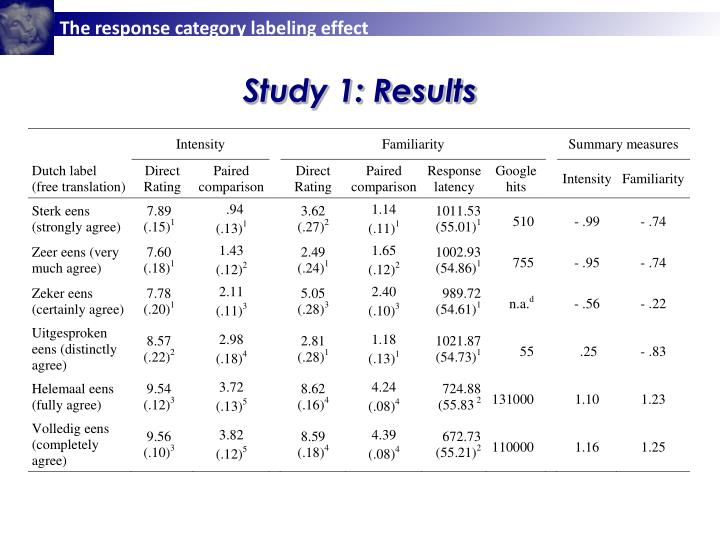
PPT - The Effect of Familiarity with the Response Category Labels on Item Response to Likert ...
(PDF) A Comparison of Psychometric Properties and ... - ResearchGate Findings indicate that having more scale points seems to reduce skewness, and the 11-point scale, ranging from 0 to 10, has the smallest kurtosis and is closest to normal. Only the 6- and 11-point...

Popular 5-point Likert scales | How to conduct research and statistics | Pinterest | Research ...
Likert Scale Surveys: Why & How to Create Them (With Examples) Advantages of Using Likert Scale 1. Easy for Respondents to Take 2. Offers Quantifiable Data 3. Versatile 4. Easy to Compare With Other Samples How to Design an Effective Likert Scale Survey 1. Curate Precise and Powerful Statements 2. Choose the Appropriate Adjectives 3. Make Statements To Identify Different Indicators of Your Research 4.
(PDF) Why Use 11-Point Scales? - ResearchGate The 11point scale is used in many other ongoing surveys, for example the Gsoep and World Value Study, and seems to be well handled by respo ndents. Respondents are asked to indicate the strength of...
Chapter 3: Levels Of Measurement And Scaling Figure 3.11 Semantic and semantic differential scales. Likert scales: A Likert scale is what is termed a summated instrument scale. This means that the items making up a Liken scale are summed to produce a total score. In fact, a Likert scale is a composite of itemised scales.
Likert scale & surveys - best practices | intelligent measurement For example, scales that are marked "1 to 5, with 5 being the highest" result in less accurate results than scales with labels such as "good" or "poor". If numbered scales are used, signposts are recommended (e.g. put "poor" above 1, "satisfactory" above 3 and "excellent" above 5). Labelled scales need to be as accurate as possible.




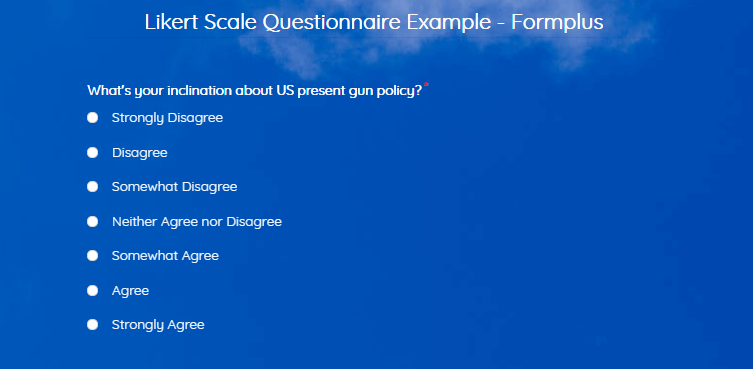
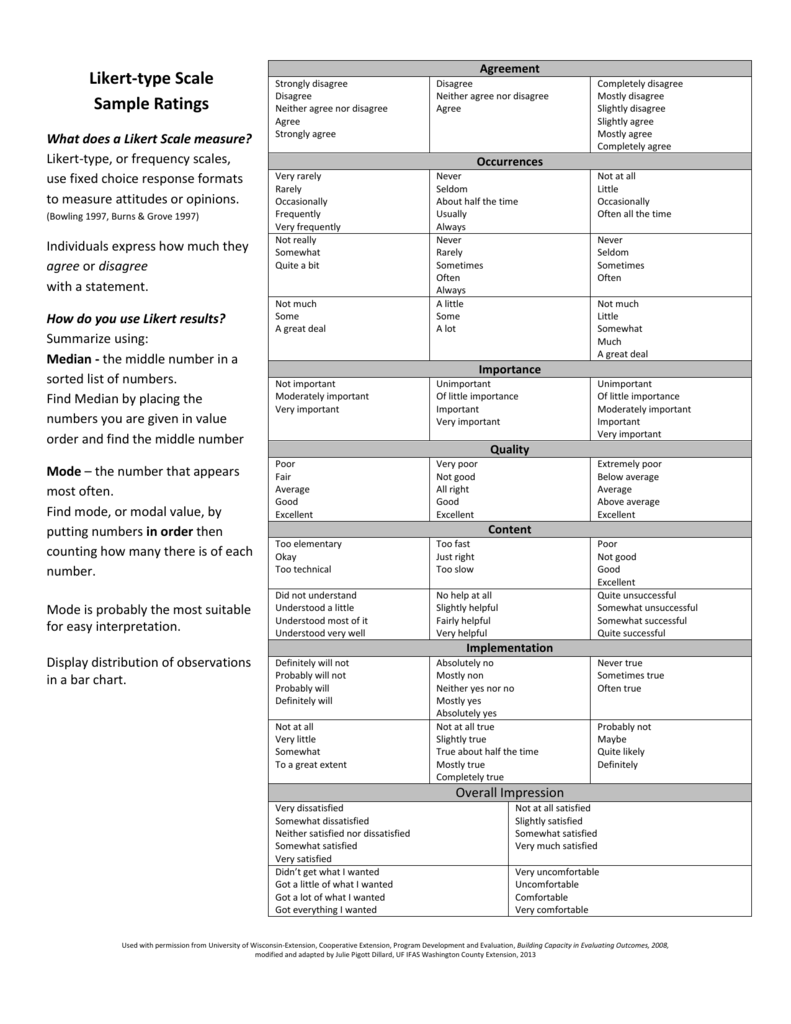

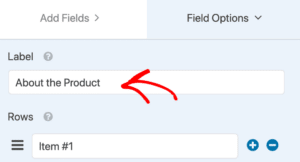
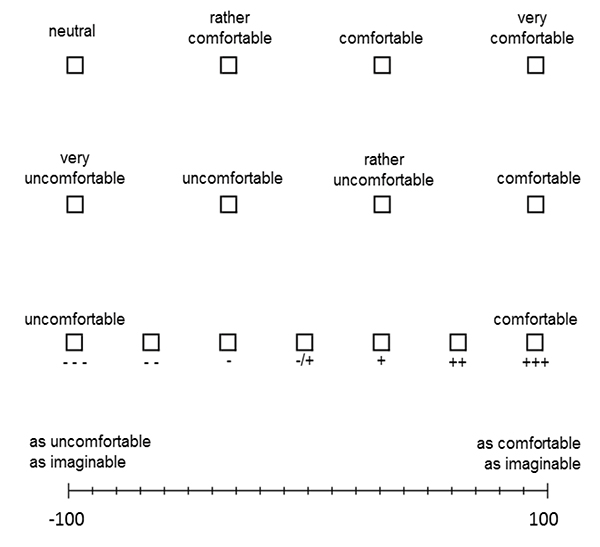
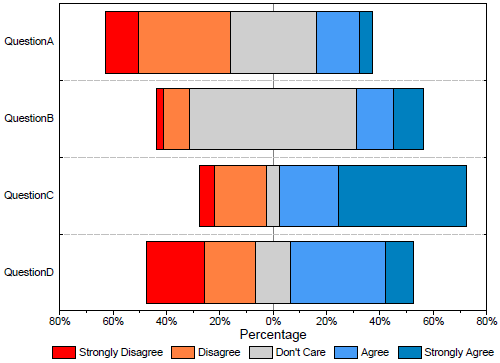


Post a Comment for "42 11 point likert scale labels"